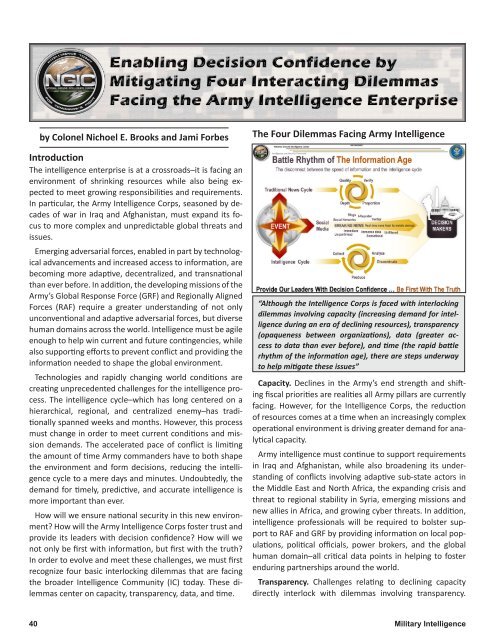incorrect
2015_02
2015_02
- No tags were found...
Create successful ePaper yourself
Turn your PDF publications into a flip-book with our unique Google optimized e-Paper software.
y Colonel Nichoel E. Brooks and Jami Forbes<br />
Introduction<br />
The intelligence enterprise is at a crossroads–it is facing an<br />
environment of shrinking resources while also being expected<br />
to meet growing responsibilities and requirements.<br />
In particular, the Army Intelligence Corps, seasoned by decades<br />
of war in Iraq and Afghanistan, must expand its focus<br />
to more complex and unpredictable global threats and<br />
issues.<br />
Emerging adversarial forces, enabled in part by technological<br />
advancements and increased access to information, are<br />
becoming more adaptive, decentralized, and transnational<br />
than ever before. In addition, the developing missions of the<br />
Army’s Global Response Force (GRF) and Regionally Aligned<br />
Forces (RAF) require a greater understanding of not only<br />
unconventional and adaptive adversarial forces, but diverse<br />
human domains across the world. Intelligence must be agile<br />
enough to help win current and future contingencies, while<br />
also supporting efforts to prevent conflict and providing the<br />
information needed to shape the global environment.<br />
Technologies and rapidly changing world conditions are<br />
creating unprecedented challenges for the intelligence process.<br />
The intelligence cycle–which has long centered on a<br />
hierarchical, regional, and centralized enemy–has traditionally<br />
spanned weeks and months. However, this process<br />
must change in order to meet current conditions and mission<br />
demands. The accelerated pace of conflict is limiting<br />
the amount of time Army commanders have to both shape<br />
the environment and form decisions, reducing the intelligence<br />
cycle to a mere days and minutes. Undoubtedly, the<br />
demand for timely, predictive, and accurate intelligence is<br />
more important than ever.<br />
How will we ensure national security in this new environment?<br />
How will the Army Intelligence Corps foster trust and<br />
provide its leaders with decision confidence? How will we<br />
not only be first with information, but first with the truth?<br />
In order to evolve and meet these challenges, we must first<br />
recognize four basic interlocking dilemmas that are facing<br />
the broader Intelligence Community (IC) today. These dilemmas<br />
center on capacity, transparency, data, and time.<br />
The Four Dilemmas Facing Army Intelligence<br />
“Although the Intelligence Corps is faced with interlocking<br />
dilemmas involving capacity (increasing demand for intelligence<br />
during an era of declining resources), transparency<br />
(opaqueness between organizations), data (greater access<br />
to data than ever before), and time (the rapid battle<br />
rhythm of the information age), there are steps underway<br />
to help mitigate these issues”<br />
Capacity. Declines in the Army’s end strength and shifting<br />
fiscal priorities are realities all Army pillars are currently<br />
facing. However, for the Intelligence Corps, the reduction<br />
of resources comes at a time when an increasingly complex<br />
operational environment is driving greater demand for analytical<br />
capacity.<br />
Army intelligence must continue to support requirements<br />
in Iraq and Afghanistan, while also broadening its understanding<br />
of conflicts involving adaptive sub-state actors in<br />
the Middle East and North Africa, the expanding crisis and<br />
threat to regional stability in Syria, emerging missions and<br />
new allies in Africa, and growing cyber threats. In addition,<br />
intelligence professionals will be required to bolster support<br />
to RAF and GRF by providing information on local populations,<br />
political officials, power brokers, and the global<br />
human domain–all critical data points in helping to foster<br />
enduring partnerships around the world.<br />
Transparency. Challenges relating to declining capacity<br />
directly interlock with dilemmas involving transparency.<br />
40 Military Intelligence


